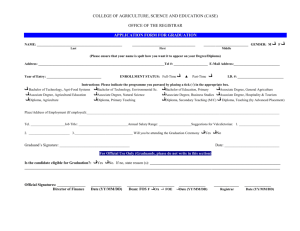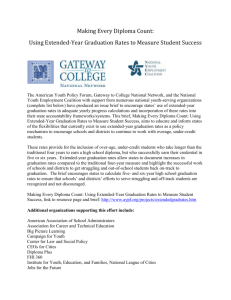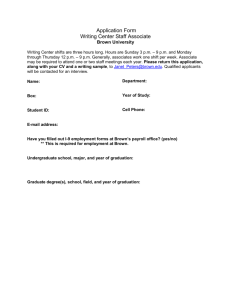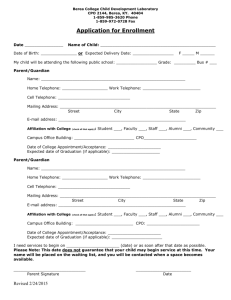Article for Jan. 5 Lesson
advertisement
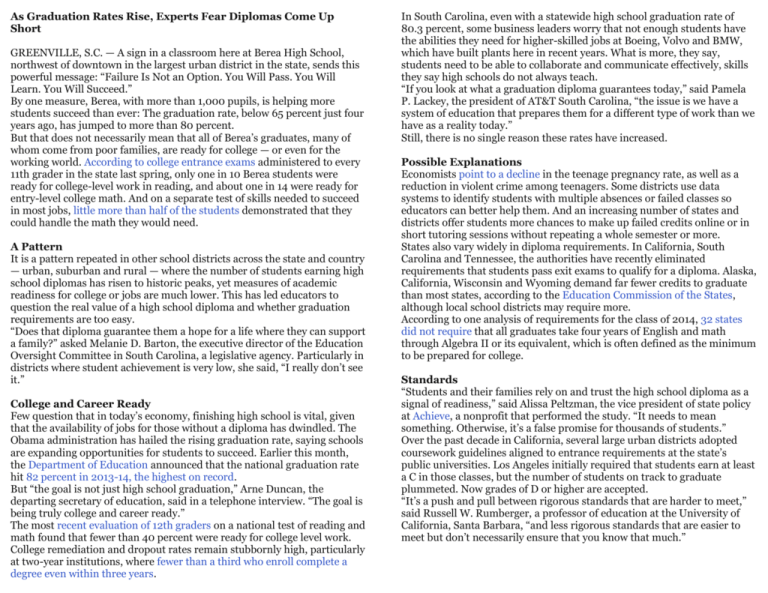
As Graduation Rates Rise, Experts Fear Diplomas Come Up Short GREENVILLE, S.C. — A sign in a classroom here at Berea High School, northwest of downtown in the largest urban district in the state, sends this powerful message: “Failure Is Not an Option. You Will Pass. You Will Learn. You Will Succeed.” By one measure, Berea, with more than 1,000 pupils, is helping more students succeed than ever: The graduation rate, below 65 percent just four years ago, has jumped to more than 80 percent. But that does not necessarily mean that all of Berea’s graduates, many of whom come from poor families, are ready for college — or even for the working world. According to college entrance exams administered to every 11th grader in the state last spring, only one in 10 Berea students were ready for college-level work in reading, and about one in 14 were ready for entry-level college math. And on a separate test of skills needed to succeed in most jobs, little more than half of the students demonstrated that they could handle the math they would need. A Pattern It is a pattern repeated in other school districts across the state and country — urban, suburban and rural — where the number of students earning high school diplomas has risen to historic peaks, yet measures of academic readiness for college or jobs are much lower. This has led educators to question the real value of a high school diploma and whether graduation requirements are too easy. “Does that diploma guarantee them a hope for a life where they can support a family?” asked Melanie D. Barton, the executive director of the Education Oversight Committee in South Carolina, a legislative agency. Particularly in districts where student achievement is very low, she said, “I really don’t see it.” College and Career Ready Few question that in today’s economy, finishing high school is vital, given that the availability of jobs for those without a diploma has dwindled. The Obama administration has hailed the rising graduation rate, saying schools are expanding opportunities for students to succeed. Earlier this month, the Department of Education announced that the national graduation rate hit 82 percent in 2013-14, the highest on record. But “the goal is not just high school graduation,” Arne Duncan, the departing secretary of education, said in a telephone interview. “The goal is being truly college and career ready.” The most recent evaluation of 12th graders on a national test of reading and math found that fewer than 40 percent were ready for college level work. College remediation and dropout rates remain stubbornly high, particularly at two-year institutions, where fewer than a third who enroll complete a degree even within three years. In South Carolina, even with a statewide high school graduation rate of 80.3 percent, some business leaders worry that not enough students have the abilities they need for higher-skilled jobs at Boeing, Volvo and BMW, which have built plants here in recent years. What is more, they say, students need to be able to collaborate and communicate effectively, skills they say high schools do not always teach. “If you look at what a graduation diploma guarantees today,” said Pamela P. Lackey, the president of AT&T South Carolina, “the issue is we have a system of education that prepares them for a different type of work than we have as a reality today.” Still, there is no single reason these rates have increased. Possible Explanations Economists point to a decline in the teenage pregnancy rate, as well as a reduction in violent crime among teenagers. Some districts use data systems to identify students with multiple absences or failed classes so educators can better help them. And an increasing number of states and districts offer students more chances to make up failed credits online or in short tutoring sessions without repeating a whole semester or more. States also vary widely in diploma requirements. In California, South Carolina and Tennessee, the authorities have recently eliminated requirements that students pass exit exams to qualify for a diploma. Alaska, California, Wisconsin and Wyoming demand far fewer credits to graduate than most states, according to the Education Commission of the States, although local school districts may require more. According to one analysis of requirements for the class of 2014, 32 states did not require that all graduates take four years of English and math through Algebra II or its equivalent, which is often defined as the minimum to be prepared for college. Standards “Students and their families rely on and trust the high school diploma as a signal of readiness,” said Alissa Peltzman, the vice president of state policy at Achieve, a nonprofit that performed the study. “It needs to mean something. Otherwise, it’s a false promise for thousands of students.” Over the past decade in California, several large urban districts adopted coursework guidelines aligned to entrance requirements at the state’s public universities. Los Angeles initially required that students earn at least a C in those classes, but the number of students on track to graduate plummeted. Now grades of D or higher are accepted. “It’s a push and pull between rigorous standards that are harder to meet,” said Russell W. Rumberger, a professor of education at the University of California, Santa Barbara, “and less rigorous standards that are easier to meet but don’t necessarily ensure that you know that much.” “It had become very easy” In South Carolina, students must take four years of English and math and three years of social studies and science. Last year, the legislature voted to eliminate the exit exam. Parents of students with disabilities argued that the test made it difficult for their children to graduate, while business leaders said it did not indicate that students were ready for work. “Quite honestly, it had become very easy, and it didn’t mean a lot,” said Molly Spearman, the state superintendent of education. Last year, the legislature required all 11th graders to take a test assessing college and career readiness, as well as an exam that measured academic skills needed for most jobs. The first results, from the ACT college admissions tests, showed that only about a quarter of students statewide were ready for either college-level math or reading. Just 6 percent of black students and 15 percent of Hispanic students scored ready for college in math, with only slightly higher rates for reading. In one poor rural district where most of the students are African-American, graduation rates have risen to more than 85 percent, yet not one student scored high enough on the ACT to be deemed ready for college in reading or math. Back to Reality Even on simpler tests of the cognitive skills needed for many jobs, fewer than two-thirds of South Carolina 11th graders could show sufficient skills in both math and reading. Here at Berea High School, a rare, racially integrated campus with similar numbers of African-American, Hispanic and white students, administrators are proud of the rising graduation rate. Addressing the low scores on the ACT, administrators said many 11th graders had not yet learned the material covered when they took the test. And some educators say such tests do not accurately predict whether students will do well in college or in the workplace anyway. Imari Nicholson, a 17-year-old student at Berea, has expressed interest in sports therapy or dentistry. After he failed chemistry his junior year, his counselor reminded him that he would need the course to qualify for a college program in his chosen fields. He is retaking it this semester. This time, he is getting an A. But he said he was not satisfied with his scores on the ACT, which indicated that he was not yet ready for college. “I expect better of myself,” he said. ARTICLE EXIT QUESTIONS: 1. After reading this article, what do you believe is the biggest challenge facing future students? Explain in 3-5 sentences. 2. Who most likely wrote this article? Explain your answer using evidence from the article. 3. Write 3 questions you’d ask the writer to help you understand this issue better. 4. What conclusions can we draw from the information presented in this article? 5. Do you agree or disagree with the information provided in this article? Explain your response using specific examples from the article.


